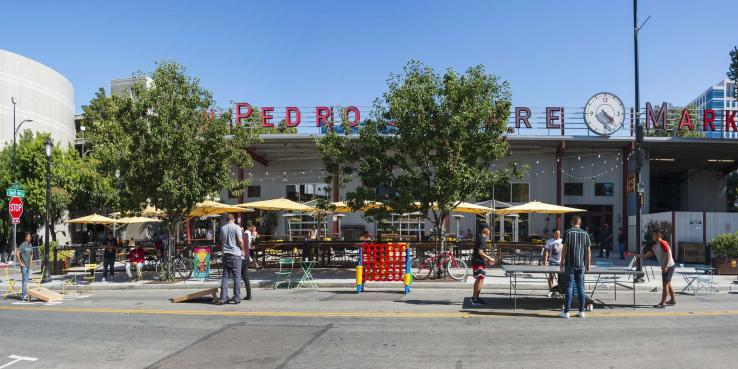This editorial first appeared in San José Spotlight.
Over the past several weeks, we have seen the rippling effects that the pandemic has brought to neighborhoods throughout San José.
With shelter-in-place orders spanning across the region, our day-to-day lives have been completely turned upside down. This pandemic has magnified deep challenges and disparities in our business community; many small and micro business owners are people of color. We need to act swiftly to ensure these businesses are able to reopen and facilitate their renewed operation.
Although there is uncertainty as to how life will be over the long term, we know that we will need to remain nimble and creative to support a reactivation of public life. Outdoor community connections are essential for our well-being, quality of life and physical health during this pandemic. As shelter-in-place orders are relaxed, we must consider how we emerge from this period safely while creatively supporting business activity.
That is why we are thrilled by the proposed San José Al Fresco initiative. We applaud Mayor Sam Liccardo and Councilmember Dev Davis for proposing this program in an effort to ease the burden on our business community.
We urge the City Council to package this initiative with additional measures and use this opportunity to pilot new ideas that could become permanent. This is San José’s time to lead — to make public life the focus of our recovery strategy. We can support our small and micro businesses by taking advantage of the city’s great weather, existing public life strategy and lessons learned from the successful Viva Calle SJ open streets program and allow businesses to serve our residents safely and in a way that allows us to support them while reconnecting with one another.
SPUR recommends the following:
Create business-recovery zones
The City Council should create business-recovery zones in areas throughout San José with a high density of ground floor commercial activity. Because restaurants and bars will not be permitted to maintain the same indoor capacity levels, we suggest that staff temporarily close off the adjacent streets or temporarily transform a lane of parking or traffic to allow for these businesses to spill out onto the street.
Due to social-distancing standards, we need to increase outdoor seating capacity. In most commercial districts, the width of the sidewalk is not wide enough to accommodate additional seating plus allow for accessible pedestrian use. In an effort to deploy these closures rapidly and cost-efficiently, we suggest the city leverage the principles and tools of tactical urbanism — street paint, planters as blockades, parklets and easily distributable outdoor furniture — as fast and inexpensive ways to test out changes to the built environment.
To balance outdoor dine-in access and takeout services, we recommend that alleyways and surface parking lots be utilized as designated pick-up stations for delivery services such as UberEats, Grubhub, etc.
Reduce fees and allow for implicit temporary uses
Our small businesses are under increased pressure to iterate on their existing service and business model to be able to adapt throughout the pandemic. There is a tension between the need to allow social distancing and needing the density of people to generate economic vitality. This is also costing our businesses greatly. We recommend that the City Council waive sidewalk cafe and parklet permitting fees during this time.
Additionally, we recommend that city staff allow for businesses to provide additional offers and services outside of what their active use permit states. In order to meet their financial needs, our bars, restaurants and other street-facing commercial operations will need to evolve. This may mean that they begin to distribute and sell additional goods and services as well as host entertainment activities.
Consider capping delivery fees
We recommend that staff analyze the impact of service delivery fees on food and beverage businesses. Third-party delivery firms usually charge restaurants and bars up to a 30 percent commission fee from every customer’s order, which can make it difficult for local restaurants to make a profit. Cities such as San Francisco, Seattle and Washington, D.C. have begun to cap the service fee at 15%; New York City is examining capping this at 10%.
While we do not want to discourage delivery service altogether, as these platforms serve a need and employ local residents, we must identify any and all measures to facilitate a resumption of on-premise operations as well.
Rethink parks and parking lots as multi-use spaces
In an effort to maximize space throughout the city, we should allow for parks, parking lots and alleyways to be reimagined for additional outdoor seating use. Many of our food and beverage establishments in San José are not located in traditional business districts where spilling out onto the street would be permissible.
These public spaces can also host temporary art installations as a way to create moments of joy throughout the city. As we encounter more large swaths of vacant parking lots and empty storefronts, art can create visual connection along our street network to keep people engaged.
